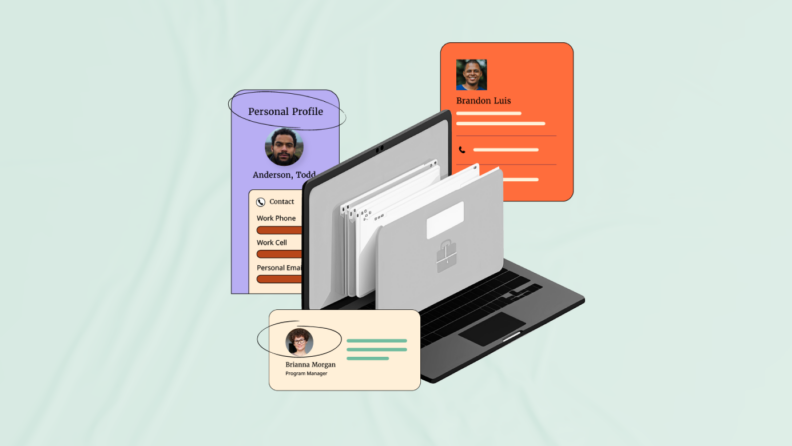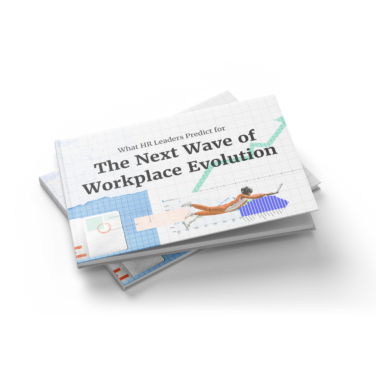Recently, People Managing People spoke to a number of HR leaders about how HR can make a bigger impact in organizations.
Nearly all of them spoke about the importance of using data to drive decision-making, which is commensurate with the rise in the people analytics discipline.
Employee data is required for legal purposes, but it helps tell a story about what’s happening in your organization and guides your talent management strategy.
But what is employee data exactly, and how do you capture it? Further, what are the ethical considerations and how do you keep the data secure?
Types Of Employee Data
Let us begin our journey through the world of employee data with a closer look at the different kinds of data points we deal with on a daily basis.
We're not diving into complex data theory here—consider this more like a casual lunch and learn.
Personal information:
- The basics: name, date of birth, address, and so on.
Employment information:
- Job description, job title, and department
- Start date
- Employment details and status (full-time, part-time, contract, etc.)
- Compensation details (salary, bonuses, benefits)
- Work location and office assignment
Educational and professional background:
- Academic qualifications (degrees, schools attended)
- Professional certifications
- Previous work experience
Performance and work history:
- Performance evaluations and appraisals
- Work assignments and projects
- Salary history
- Promotions and transfers
- Disciplinary actions and warnings
Time tracking and attendance records:
- Timesheets and attendance records
- Overtime and time off requests
- Employee time and attendance history
Benefits and compensation:
- Health insurance information
- Retirement plan details
- Stock options or equity grants
- Tax withholding information
- Deductions and contributions
Emergency contact information:
- Names and contact information of next of kin or emergency contacts
Diversity and demographics information:
- Gender
- Race/ethnicity
- Disability status
- Veteran status (if relevant)
Personnel information
- Headcount
Legal and compliance documents:
- Employment contracts
- Non-disclosure agreements (NDAs)
- Confidentiality agreements
- I-9 forms (employment eligibility verification)
- Tax forms (W-4, W-2, 1099, etc.)
Performance metrics and goals:
- Key performance indicators (KPIs)
- Goals and objectives
- Performance reviews including performance data
- Performance improvement plans (PIPs)
Training and development:
- Training history and certifications
- Skills and competency assessments
Exit and termination records:
- Exit interviews
- Employment length
- Termination reasons
- Final pay and benefits information
Employee engagement
- Survey feedback
- Interview feedback
- Employee net promoter score
Recruitment metrics
- Source of hire
- Job offer acceptance rate
- Cost per hire
- Time to hire
The above data can be combined in increasingly advanced ways to improve processes and the overall employee experience.
For example, you might want to look at attrition rates across certain demographics, or if people are leaving soon after getting promoted.
You can then present this data to the relevant stakeholders and allocate resources appropriately.
Why Is Employee Data Useful?
Employee data is key for making smart workforce decisions and staying compliant with labor laws, tax rules, and data privacy regulations.
For example, orgz need to maintain accurate payroll records, including wages paid, tax withholdings, and employer contributions, to stay compliant with tax laws and ensure proper reporting to government agencies.
That’s the boring stuff but, as alluded to in the intro, employee data like demographics, attrition rates, and other HR metrics can be used to tell a story about what’s happening in your org and use it to make strategic decisions.
For example, IBM conducted an in-depth analysis of employee attrition to identify key factors influencing turnover. They discovered that employees who traveled frequently had a 2.4 times higher attrition rate than those who rarely traveled.
Additionally, employees in the Human Resources department exhibited a higher tendency to leave. These insights enabled IBM to address specific issues and develop strategies to reduce turnover.
How To Collect Employee Data
The good news is that collecting all of this data is quite straightforward if you have the right tools.
Human resource information system (HRIS)
An HRIS helps you organize and store all your employee data digitally in one centralized location, making it easy to access and update.
It automates everyday HR tasks like tracking time off and managing employee records, and you can run quick reports to spot trends or stay compliant with labor laws.
Human resources management system (HRMS)
An HRMS is a more comprehensive solution that goes beyond an HRIS by integrating with other business functions. It not only helps in data collection but also supports workforce planning, payroll processing, and compliance management.
Applicant tracking systems (ATS)
Playing a pivotal role in the early stages of data collection, specifically during recruitment, an ATS facilitates data collection on candidates' qualifications, experiences, and interview feedback. This data can then be transitioned into HRIS or HRMS once a candidate becomes a new hire.
People analytics software
Specialist people analytics software allows you to not only collect but also analyze employee data to gain insights into workforce trends, performance metrics, and predictive analytics. Often highly specialised, these enable HR teams to make strategic decisions that drive organizational success.
Recruitment analytics software
Specialized recruitment analytics software, designed with advanced recruitment analytics capabilities to delve deep into the hiring process.
HR professionals and recruitment teams use it to gain insights into their recruitment strategies and make data-driven decisions.
Surveys and employee interviews
Methods like surveys, skip-levels and stay interviews provide you with valuable employee feedback, sentiments, and suggestions.
This qualitative data from tools like employee survey software complements the quantitative data stored in HRIS/HMRS and provides a holistic view of employee experiences and perceptions.
Performance review software
Performance management tools help track and store key employee data like goals, feedback, reviews, and development plans in one accessible location.
This makes it easier to spot trends, support growth, and make informed decisions about promotions or training.
Employee Data Best Practices
Managing employee data is a balancing act to adhere to best practices and ensure data security, compliance with regulations, and the ethical treatment of your workforce.
Data hygiene best practices
Data hygiene is essential for maintaining the quality, accuracy, and usefulness of your data. Poor data hygiene can lead to all sorts of errors, inefficiencies, and missed opportunities.
Here’s what to do:
- Data accuracy and integrity: Maintain accurate and up-to-date employee records. To do this, routinely audit and verify data to ensure its accuracy. Inaccurate data can lead to errors in payroll, benefits, and problems (i.e. disaster).
- Data retention policies: Develop clear data retention policies that specify how long you will retain employee data and when it should be securely deleted or archived. This ensures compliance with legal requirements and reduces data clutter.
- Data disposal: When disposing of physical or electronic records, follow secure data destruction procedures. Shred paper documents and securely wipe electronic media to prevent data leakage.
- Data backups: Regularly backup employee data to prevent loss in the event of system failures or data corruption. Test data restoration procedures to ensure data recoverability.
Security
Security impacts us all, and it’s especially crucial to secure your organization’s sensitive data.
For example, in September 2024, the UK Information Commissioner's Office fined the Police Service of Northern Ireland £750,000 for failing to implement appropriate measures to protect employee’s personal data, highlighting the severe consequences of such breaches.
With this in mind, here are some best practices to consider when addressing security:
- Regular data risk assessments: Conduct regular assessments of data risks and vulnerabilities to identify potential threats and weaknesses in your data management practices and take corrective actions. If you need help getting these systems in place, then reach out to a data governance consultant for the support you need.
- Incident response plan: Develop and document a comprehensive incident response plan to address data breaches or security incidents promptly. Ensure employees know the steps to follow in the event of a data breach and embed it into your company culture.
- Cybersecurity measures: Employ robust cybersecurity measures such as encryption, firewalls, and multi-factor authentication to safeguard sensitive information.
- Access control: Implement strict access controls to restrict who can access employee data. You’ll want to grant access only to authorized personnel based on their roles and responsibilities. Regularly review and update access permissions to minimize the risk of data breaches.
- Vendor and third-party risk management: If you use third-party HR software or services, conduct due diligence to assess their data security practices. For example, look out for certifications like ISO 27001, SOC 2, and ensure they comply with the same data protection standards you follow internally.
- Data privacy compliance: Stay up-to-date with data privacy regulations such as GDPR (General Data Protection Regulation), CCPA (California Consumer Privacy Act), and other relevant laws. Ensure that you collect, store, and process employee data in accordance with these regulations. Remember, you’ll need to obtain consent when required.
- Audit trails and logging: Maintain audit trails and logs of data access and changes. These records can help in investigating security incidents and demonstrating compliance with data protection regulations.
Ethics
Prioritize ethical considerations in all aspects of your data handling to ensure fairness, respect, and trust in your organization's practices.
- Encourage responsible data practices from the beginning (employee onboarding) and discourage any misuse or unauthorized sharing of employee information.
- Obtain informed consent from employees before collecting and processing their data. Be transparent about how their data will be used and provide transparent privacy notices.
- Training programs to train HR professionals and employees on how to store data and data protection best practices. Foster a culture of data privacy awareness throughout your work environment to minimize the risk of accidental data exposure.
Employee Data: Manage Casually At Your Peril
In the daily routine of managing a workforce, we naturally gather and maintain a multitude of employee details and it’s essential to keep in mind that this isn't a casual endeavor to take or leave.
Managing employee data is a multifaceted task that requires a delicate balance between legal compliance, data security, and ethical considerations. It’s not for the faint-hearted.
So remember, when it comes to employee data, it's better to be overly protective than to take a casual approach. Your employees' trust and your organization's reputation depend on it.
To not end on such a serious note, also remember that employee data is like a superpower to help HR become a more strategic partner. You can even have a little fun with it too.
Learn how you can best present data in Liam Reese’s excellent article on HR data analysis.
You might want to increase your data proficiency by attending a conference on people analytics or taking a HR analytics course and/or record management certification.
Subscribe To The People Managing People Newsletter
For more on employee data and strategic talent management, subscribe to our weekly newsletter for HR and business leaders. You’ll receive all our latest content to help you grow in your career and make greater impact in your org.




